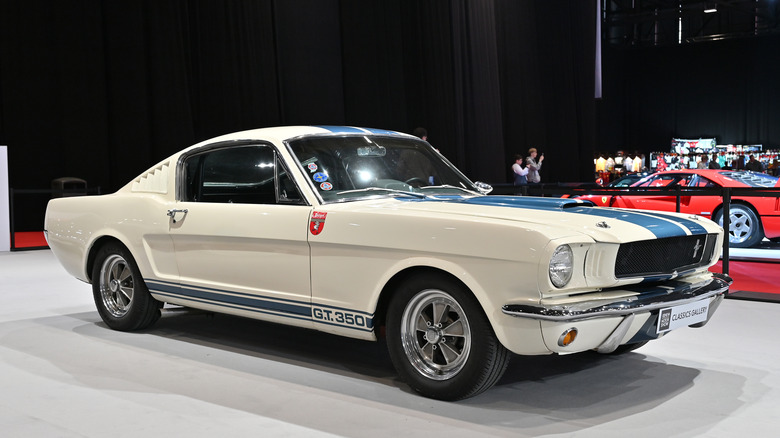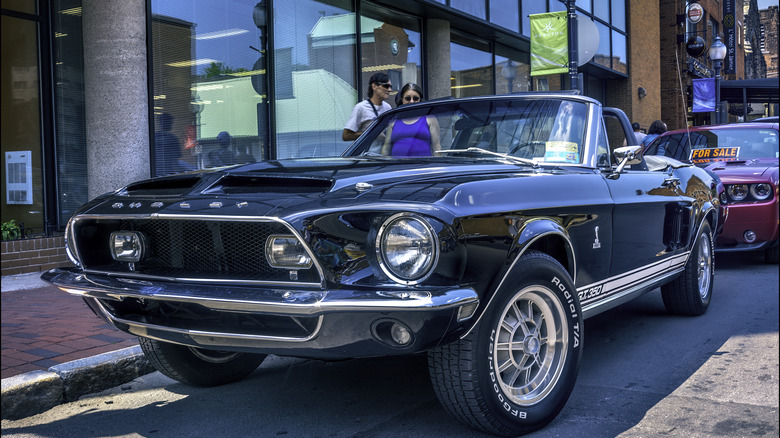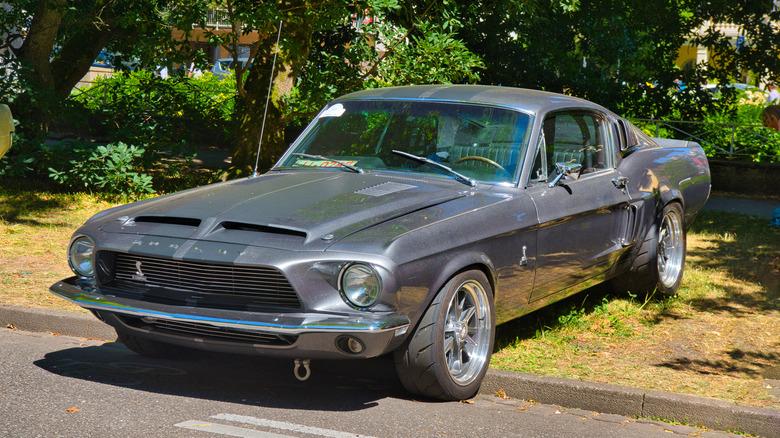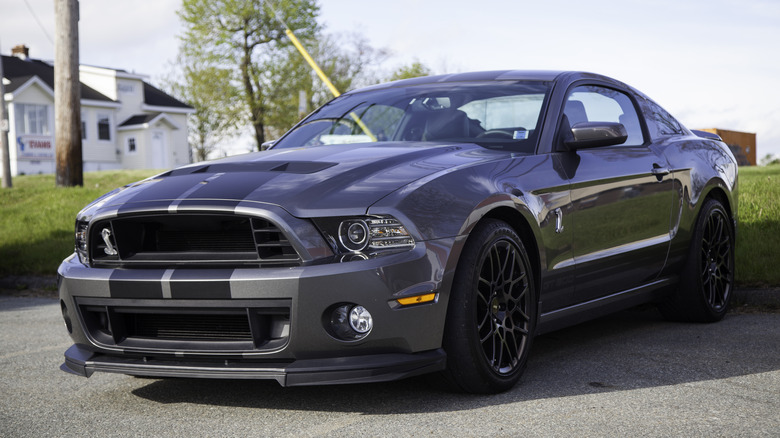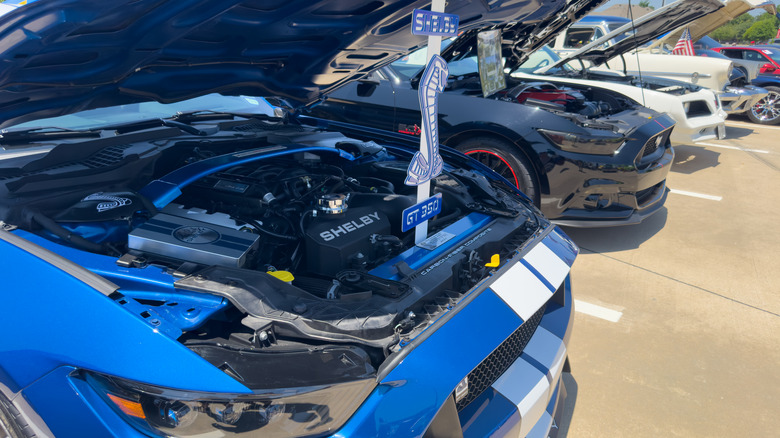What's The Difference Between A Shelby Mustang And A Regular Mustang?
The automotive world can be a very mysterious one. The fact is, vehicle lines and model families can become incredibly convoluted, with histories that span decades. Sometimes, specific models undertake dramatic redesigns. It's easy to tell at a glance whether you're looking at a Corvette C6 or a Corvette C7, for instance, given the inside-and-outside overhaul the change represented. With venerable vehicles like the Ford Mustang, however, questions will arise.
April 2024 marks six decades of the Mustang, with Ford lining up a 60th Anniversary Appearance Package for the latest model to mark the occasion. Over that long life, some unique additions to the family surfaced, with a notable example arriving in its first decade of life: the Shelby Mustang. Though a Mustang through and through, the formidable Shelby had a unique appeal.
Let's take a look at the concept behind the Shelby Mustang, where it fit in with the regular lineup, how it differentiated itself, and how its future in the auto world would pan out.
When were the first Shelby Mustangs introduced?
The Shelby Mustang began production in January 1965, as the Shelby GT350. It was the brainchild of the acclaimed Carroll Shelby, who by this time triumphed in the 24 Hours of Le Mans in 1959 and created his brand, Shelby American, in 1962. The company developed the formidable racing machine the Cobra, which would snatch victory at the World Manufacturers' GT Championship months after the GT350 arrived. With the racing legend's cachet behind it and GT in the name, the Shelby Mustang made a clear statement: this model was intended to be fast — very fast.
The regular Ford Mustang had certainly had few issues establishing itself when it arrived the previous year. A family four-seater offering up to 271 hp in its 289 performance guise for June 1964 (leaps and bounds above the original base Mustang's 101 hp), it was a blend of practicality and power that would go on to strike a chord indeed.
With the might of mid-1960s TV commercials behind it, CBS News reports, 263,434 drivers would snap up the vehicle before the year was out. Nevertheless, as any company will tell you, there's always more money to be made. To that end, according to the company, Shelby was approached by Ford Division General Manager Lee Iacocca to help develop a new type of Mustang: A true performance model.
The specs of the Shelby Mustang
The concept of the Shelby GT350 wasn't to create an entirely new vehicle from scratch but to augment and upgrade the body of the Mustang to further enhance its image. To do so, the existing performance model (which topped out at 271 hp as we've seen) needed to be surpassed to legitimize the Shelby Mustang's existence in the first place. This being the task at hand, the GT350 was equipped with new headers and intake manifold along with a sump of aluminum and additional fuel floats. All of this helped to push performance further and keep things relatively cool and stable in the process.
The result of Shelby and the team's machinations was a car that certainly did represent a new high for the Mustang. 1965's GT350 featured a V-8 that allowed it to reach 329 lbs-ft of torque, with a lofty 306 bhp to match.
It was a machine to be reckoned with, perhaps to the extent that it wasn't practical as an everyday drive. In May 1965, Car and Driver magazine took it for a spin and concluded, "The noise level is very high, the ride is very harsh, and at low speeds, one must put plenty of effort into the steering and braking." As befits its creator, it was a performance model intended as a racing machine, its largely Mustang-standard interior belying the enhanced power. Here's how it's performed in that arena.
The exciting beginnings of the Shelby Mustang
For the original Shelby Mustang, specs were the primary focus over aesthetics. As Tom Corcoran puts it in Shelby Mustang, "Every change ordered from Ford and installed by Carroll Shelby's factory personnel during the 1965 model year related directly to improved road-course performance and durability." As such, it would have been a real shame if the machine couldn't tear it up on the track.
It didn't matter what kind of track, either. Corcoran notes that limited numbers of GT-350s were also built to drag race (13 of them in the model's first two years). Specific torque straps and rear shocks were added to accommodate the rigors of such use, and Gus Zuidema (a Ford employee who also drag raced in an adapted Shelby Cobra) rode the best-performing model, hitting 12.68 seconds in one New York contest.
The GT-350 was designed to meet the regulations of the Sports Car Club of America's Production Sports Car B Class, and the 350-R models were even further enhanced for such competition. The application of individually tuned and fitted engines, modified fenders and enhanced fuel pumps made for a track version that could output a mighty 350 hp. In its first year, 37 GT-350Rs were created (outnumbered around 15 to one by regular 350s), and the aptly named Ken Miles scored a glorious victory in the model's debut Green Valley Raceway performance in February 1965. It would be the start of an impressive career for the Shelby Mustang.
How the Shelby Mustang evolved
For a model striving to make a name for itself in the racing arena, developing a reputation as the Flying Mustang (after it famously left the ground entirely for a moment in that first contest at Green Valley Raceway) was quite the auspicious start. The concern, after that, was maintaining such momentum.
A contemporary advertisement for the model from Shelby-American Inc., according to The Chicane, declared the GT-350 to be "America's fastest, race-bred stock car," and shared some race results to demonstrate just how successful its early life was. Accomplished driver Bob Johnson claimed wins at Bp in Cumberland and Mid-Ohio, Jerry Titus added a win at Kent in Washington, and Elkhart Lakes Bp was the setting for another victory from Tom Yeager, among others.
The Shelby had arrived in style and proved itself often, but the circuit is competitive in more ways than one. It was vital to demonstrate that it wasn't simply a one-year wonder, and it achieved just that. In 1966 and 1967, the 350R won the SCCA again. By 1967, the Shelby Mustang family had grown to include the GT500, a sports sedan equipped with a V-8 pushrod that could output 355 hp. The standard Mustang, a Ford classic, by comparison, would remain a powerful yet perhaps more sensible option for the average driver. This model year, the Ford Mustang topped out at 320 hp when equipped with the optional V-8 390 CID.
The Mustang legacy
The regular Ford Mustang didn't set out to be the fastest, most powerful, or most gleamingly ostentatious vehicle of its type, but rather an honest sports car with a tasteful style at an honest price. According to Ford, documents from the company specified, "a large segment of the market we were aiming at was made up of young people who ... had ... fancy tastes in durable goods – but relatively little ready cash. An early design objective was to keep the car within the range of those buyers."
It's a philosophy that has kept the Mustang family's popularity competitive with, if not dominant over, its rivals for generations of the model. In March 2024, Ford reported that the Mustang family had achieved the title of best-selling sports car in the U.S. for 2023 and had held that title worldwide for over a decade. For the seventh generation of the Ford Mustang, a Performance Pack adds MagenRide suspension and more sophisticated brakes, alongside a 315 hp EcoBoost or 480 hp V-8.
Sometimes, Shelbys have been made directly by the company. Other times, modifications have made Mustangs into Shelbys after the fact. One thing that's never changed, though, is the fact that a Shelby is a true performance Mustang. 2013's monstrous GT500 claimed the title of the strongest production V-8 on the planet, with an engine output of 662 hp. The might of the later 2020 GT500 would further cement that legacy.
